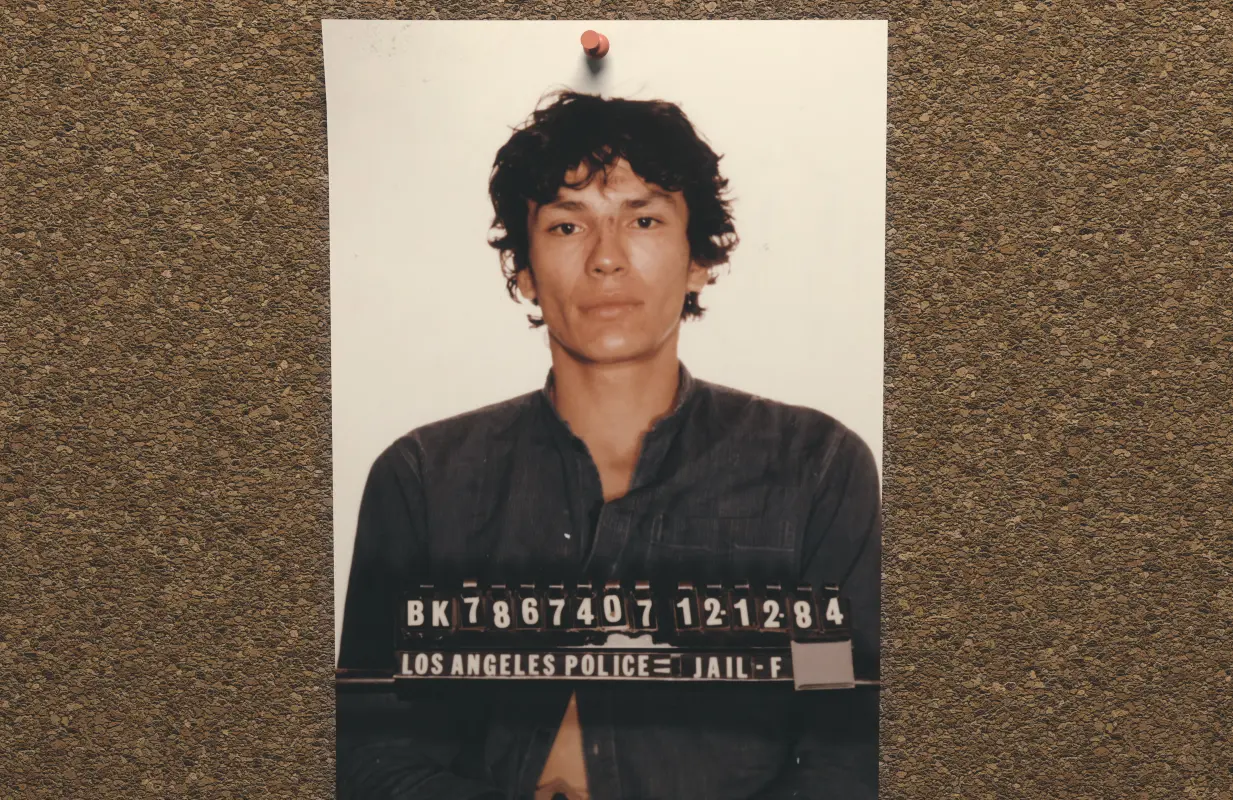Night Stalker: The Hunt for a Serial Killer Brings a Chilling Tale Back to Life
-
 Richard Ramirez faces the camera in an image from Night Stalker: The Hunt for a Serial Killer. (Netflix)
Richard Ramirez faces the camera in an image from Night Stalker: The Hunt for a Serial Killer. (Netflix)The editor-in-chief of the daily newsletter Best Evidence, Sarah D. Bunting knows a thing or two about true crime. Her weekly column here on Primetimer is dedicated to all things true crime TV.
The terrifying 1985 home-invasion spree of Richard Ramirez, aka "the Night Stalker," has long been a subject of grim true-crime fascination, but whether you're familiar with the case or not, Netflix's new four-part docuseries Night Stalker: The Hunt for a Serial Killer has a lot to offer.
Yes, there are the expected grim talking-head interviews and slow motion shots of bloody weapons falling to the floor, but director Tiller Russell, who also helmed the Amazon Prime docuseries The Last Narc and the well regarded dirty-cops feature The Seven Five, manages to put a number of less-traditional editing tricks to extremely effective use, including a manipulation of Bruce Springsteen's contemporary hit "Glory Days" in the opening episode — the choppy sound is disorienting, and sets the emotional stage for the story to come. In a later episode, Russell begins with an accelerating set of chyrons that raise the heart rate to match Ramirez's growing body count and law enforcement's increasing frustration.
Russell's handling of law enforcement is also unusual. He gets excellent access to the lead L.A. County Sheriff detectives on the Night Stalker case, Gil Carrillo and Frank Salerno, and while the focus on the investigation narrative, combined with the way the first episode takes its time with Carrillo's personal history, might feel like copaganda — and to an extent, it is — the background we get on Carrillo's time in the armed forces, and his point of view as a Mexican-American coming up in 1960s Los Angeles, provides important emotional context. These and other law-enforcement interviewees aren't perfect — one Northern California cop goes into some detail about wanting to beat cooperation out of a witness, a story Night Stalker lets play out without taking a position — but the series gives better process-y insight into the investigation than most.
At one point Salerno discusses the necessity of "maintaining an even strain" during a high-profile hunt for a serial killer, and mentions that it helped him and Carrillo that he'd gone through it before with a similar case (the Hillside Strangler case, a decade earlier). The sequence in which Ramirez is apprehended begins at a Greyhound bus depot where Ramirez immediately "makes" the undercover cops posing as homeless people; the partners walk us through why that happened without sapping the incident of suspense. And both partners get emotional recalling interviews with various survivors of Ramirez's predations, even after three and a half decades.
Night Stalker is, in name, about the search for the killer, but it's also about the victims, and the series strikes a good balance between law enforcement's attempts to solve the case, and survivors' and families' testimony about what happened and what was taken from them. Anastasia Hronas, six years old when Ramirez lifted her out of her bed and subjected her to a prolonged assault, gives an especially harrowing account of her ordeal, which Russell pairs with notes from the cops about linkage blindness when it came to Ramirez's crimes against children — because those crimes "belonged to" a completely different unit. It's sometimes difficult to communicate how heavily a decades-old and now-solved case hung over a community, but Night Stalker does a great job conveying the near misses and frustrations of the investigation, along with the innumerable sleepless nights for both cops and civilians.
The series has a handful of other quality hallmarks — including archival news footage featuring TV-newsmag legend Keith Morrison, who was then a local news reporter (it's good that he's chyronned; his signature plummy cadence was not yet fully developed in the eighties, and I might not have spotted him otherwise). You may also remember Zoey Tur as a talking-head in OJ: Made In America; the series could have done a better job explaining Tur's significance to Angeleno news-gathering, but she's always good for a chewy sound bite. And while part of me wanted to see another full episode on Ramirez's horrendous upbringing — which doesn't justify a single one of his actions, but based on the facts we have, it almost seems like his father was trying to create a remorseless serial murderer — and on his determined but very inexperienced legal team, which included a lawyer who's shown inviting the prosecutor to step outside at one point.
Unlike other recent true-crime limited series that bite off more than they can chew, Night Stalker keeps its focus, finds a few new ways to tell its story, and successfully immerses viewers in what was clearly a terrifying time.
Night Stalker: The Hunt For a Serial Killer drops January 13th on Netflix.
Sarah D. Bunting co-founded Television Without Pity, and her work has appeared in Glamour and New York, and on MSNBC, NPR's Monkey See blog, MLB.com, and Yahoo!. Find her at her true-crime newsletter, Best Evidence, and on TV podcasts Extra Hot Great and Again With This.
TOPICS: Night Stalker: The Hunt for a Serial Killer, Netflix, Keith Morrison, Richard Ramirez, Zoey Tur, True Crime
- Only a few of Netflix's true-crime docuseries have been hits of the 21 that have dropped so far this year
- Night Stalker's treatment of cops as gods is its biggest flaw
- Netflix's Night Stalker is a glorified police procedural that sensationalizes Richard Ramirez’s crime spree in lurid detail
- Night Stalker is "prestige true-crime" that updates trash-TV aesthetics